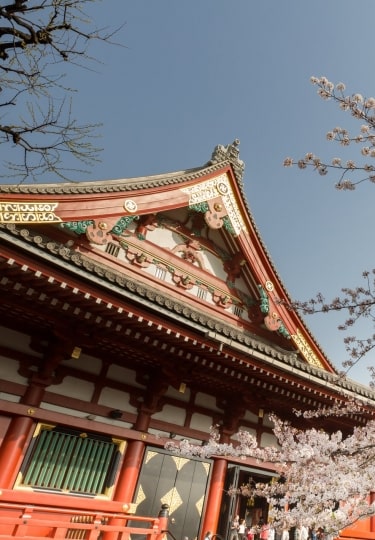As one of the world’s oldest countries, Japan has a wealth of historical treasures to discover, including hundreds of temples and shrines. While there is plenty to do and see in this fascinating destination, strolling around the grounds of at least one of these famous temples in Japan is an experience that shouldn’t be missed.
Many of the most famous temples in Japan are well over 1,000 years old and feature large complexes made up of main halls, pagodas, stunning wooden gates, statues, tea houses, gardens, and more. Several have been deemed UNESCO World Heritage Sites, while others are federally protected, as they house artifacts of religious and historical importance.
Thankfully, you’ll find it easy to see Japan’s best temples as they are scattered throughout the islands. Whether you’re visiting Tokyo, Hiroshima, or Kyoto, here are some of the best.
Kotokuin Temple, Kamakura
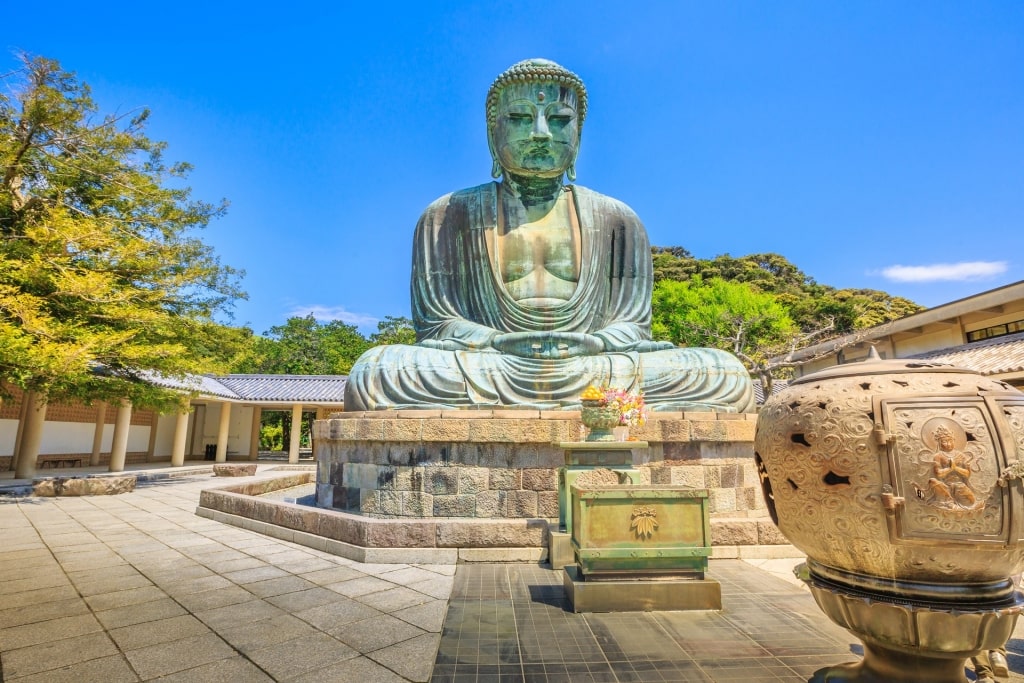
Kotokuin Temple, Kamakura
The giant, 43-foot-tall bronze Buddha statue outside Kotokuin Temple in Japan may be one of the most resilient in the world. Dating back to the 13th century, it has managed to withstand multiple earthquakes, tsunamis, and wars without so much of a chip or scratch. Located in the town of Kamakura just outside of Tokyo, Kotokuin is one of Japan’s designated “national treasures.”
Even though it weighs well over 460,000 pounds, Kotokuin’s Buddha is hollow, which allows visitors to step inside while at the temple. It’s unique because the Buddha is located in an open-air facility, rather than under a roof or other structure that would protect it from the elements.
Senso-ji Temple, Tokyo
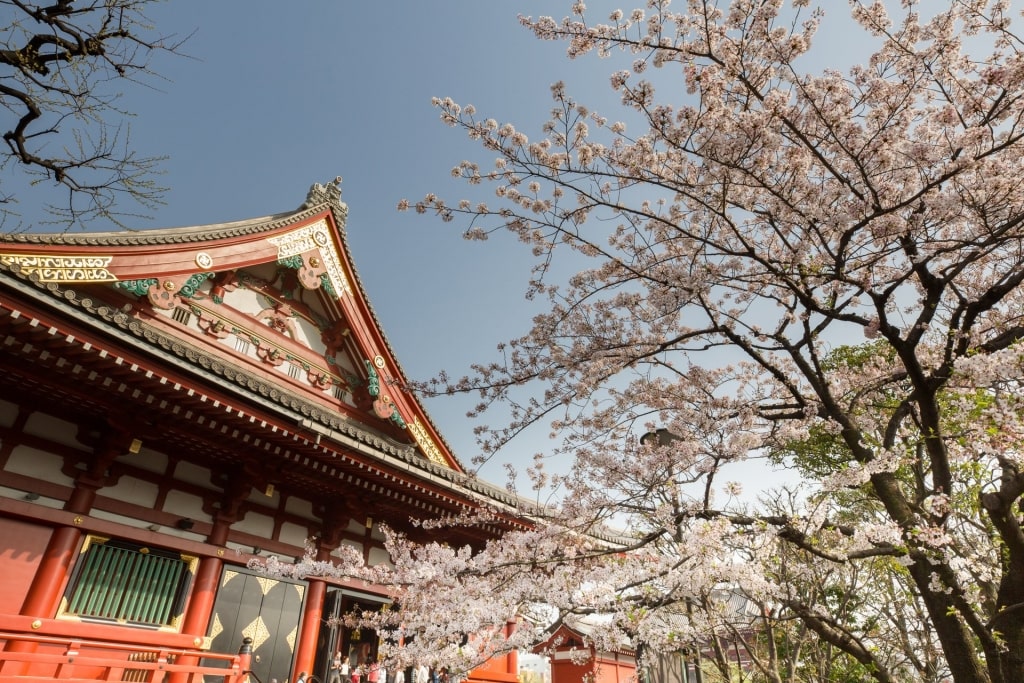
Senso-ji Temple, Tokyo
As you step through the oversized gate that leads you into the complex of Senso-ji Temple, you’ll immediately realize that this complex dates back to an earlier period in Japan’s history. Built in 645 C.E., Senso-ji is a Buddhist temple dedicated to the God of Mercy and is Tokyo’s oldest standing temple.
As with most temples, there’s a large shopping area with kiosks and vendors offering some of the best things to buy in Japan on either side leading up to the site. Though this may seem like a modern addition for tourists, many of the most famous temples in Japan have been centers of commerce for centuries.
At the end of the shopping lane, you’ll find Senso-ji temple, as well as an 80-foot-tall, five-story pagoda. While walking through the temple’s main entrance, known as the “Thunder Gate,” take time to notice the intricate carving and details, as well as the two guardian protectors perched on either side of the temple’s smaller inner gate.
Hasedera Temple, Kamakura
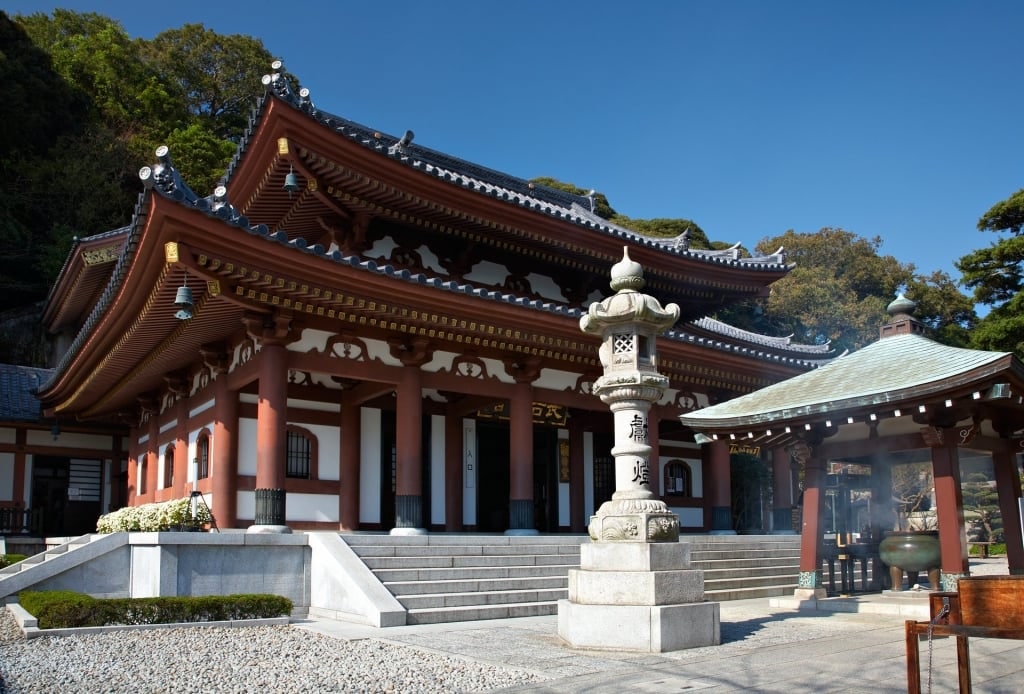
Hasedera Temple, Kamakura
Also in Kamakura, the Hasedera Temple is one of the most famous temples in Japan because of what it holds inside: a 30-foot-tall wooden statue of Kannon, the Buddhist goddess of Mercy.
Legend has it that there were two of these intricate sculptures carved in the eighth century. Devotees housed one in a temple of the same name in Nara, while this one was thrown into the sea to bring blessings wherever it washed up. Eventually, the wooden statue came ashore in Kamakura, and Hasedera Temple was built to house it.
The temple grounds are quite lush and shady, with several buildings housing prayer areas, museums, and ancient relics and texts. There’s a shrine for making wishes, a cave open to the public filled with Buddha sculptures, wooden walkways and garden paths, and a cafe selling tea, coffee, ice cream, and snacks.
Kinkaku-ji (The Golden Pavilion), Kyoto
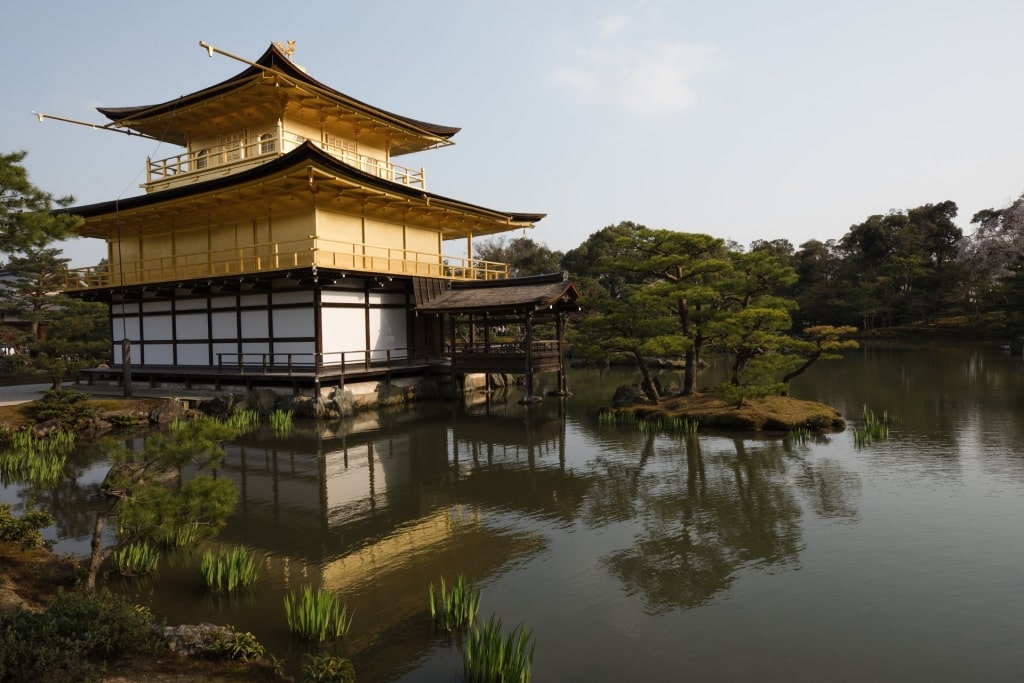
Kinkaku-ji, Kyoto
Both one of the most famous temples in Japan and one of the most photographed places in the country, Kinkaku-Ji is a must-see stop on any visit to Kyoto. This Buddhist temple was first built in the late 1300s and though it burned down in the mid-20th century, it was rebuilt soon after in the 1950s.
The main draw of this famous Japanese landmark is the Golden Pavilion, a three-story structure covered in gilded gold leaf and perched on the edge of a small pond called Kyōko-chi, or mirror pond. When the sun hits midday, the pavilion appears to glow and reflects a vivid image onto the surface of the water. (The pavilion is best photographed from the opposite side of Kyōko-chi.)
Once you’ve taken your photos, spend some time walking around the rest of the area, which features several beautiful Japanese zen gardens and small outdoor shrines.
Read: Two Days in Kyoto
Shitennō-ji, Osaka
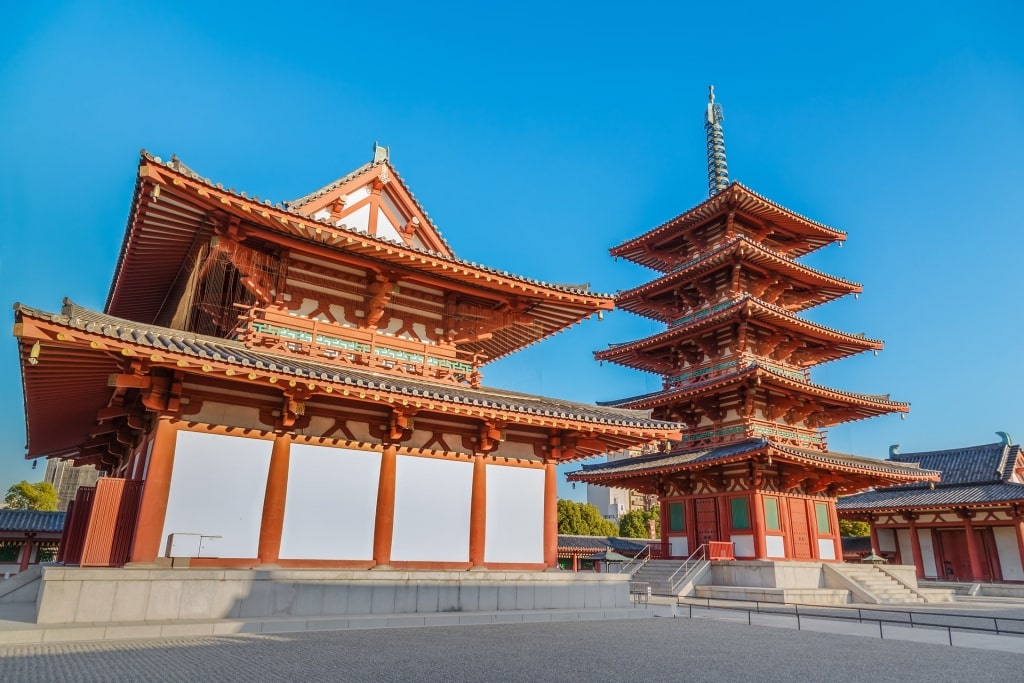
Shitennō-ji, Osaka
Shitennō-Ji is technically a government building, but it doesn’t look anything like what you’d expect. It was one of the first official buildings commissioned by the state, under the direction of the country’s leaders during the Yamato Period in the 6th century C.E.
Even though Shitennō-Ji was rebuilt on a few occasions, it’s one of the most famous temples in Japan since builders never changed the design or layout—it remains exactly how it looked in the 500s.
Visitors can climb the temple’s five-story pagoda and stroll the grounds. It’s also worth paying the small fee to access the Gokurakujodo Gardens and temple treasure house, which display artifacts and sculptures of historical and religious importance.
Ryoan-ji Temple, Kyoto
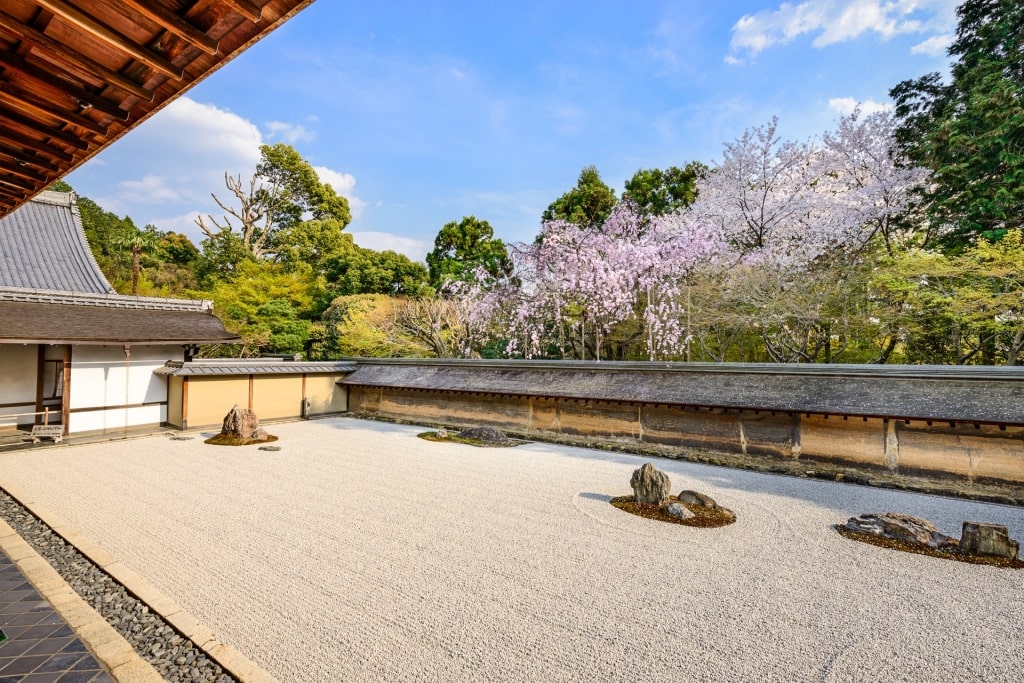
Ryoan-ji Temple, Kyoto
If you’ve ever seen a small sand garden or rock garden on someone’s desk in an office, you’ll have an idea of what to expect at Ryoan-ji Temple, since this Zen site is built around one of the largest rock gardens in Japan.
The large, sandy space has groups of rocks and boulders that are planted throughout the garden. During the day, monks tend to the garden, using rakes and tools to draw patterns and swirls. Visitors can stand on the nearby deck and watch the monks at work.
Though Ryoan-ji’s garden is one of the most impressive sites in Kyoto on its own, there is far more to see at this temple. Plan to spend at least an hour visiting its sprawling gardens, temple buildings, and homes that date back to the late 8th century. The entire complex was originally a home for an important area ruler and was converted into a temple in the 1100s.
Daishō-in, Hiroshima
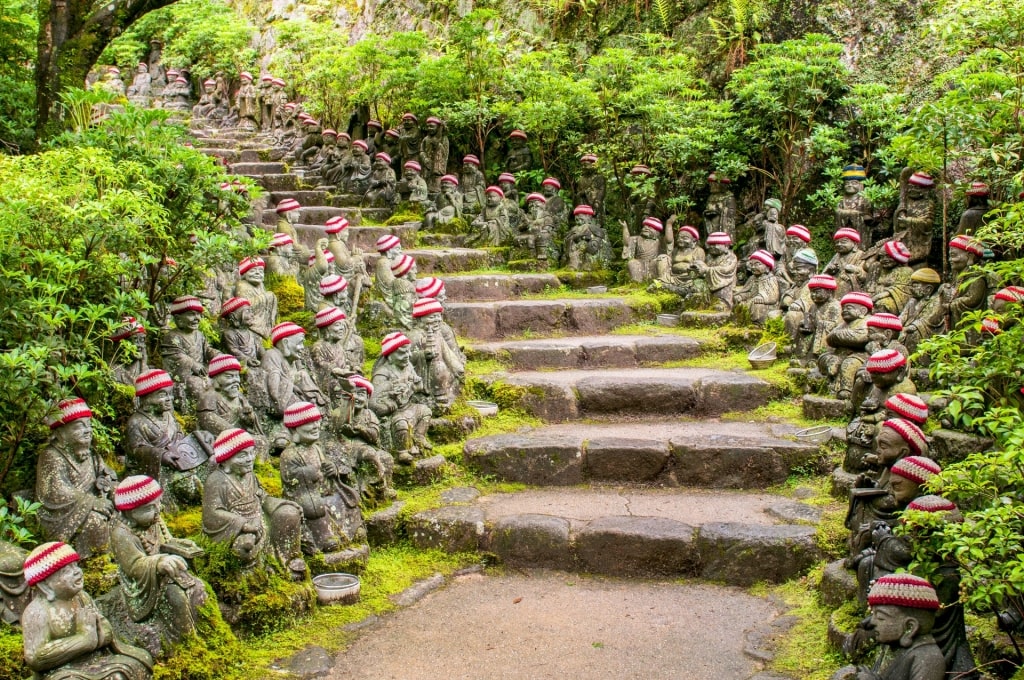
Daishō-in, Hiroshima
If you’re fortunate enough to have free time near Hiroshima, make the hour-long trip to Miyajima Island. It’s there you’ll find the Daisho-in, a forested temple hard to see from afar as it effortlessly blends into the landscape.
The temple was built at the end of the first century and has a beautiful approach with stone stairs flagged by colorful banners that reach the main temple area. As you climb the stairs, look carefully for stone buddha statues tucked under the trees. There are more than 500 sculptures within the complex.
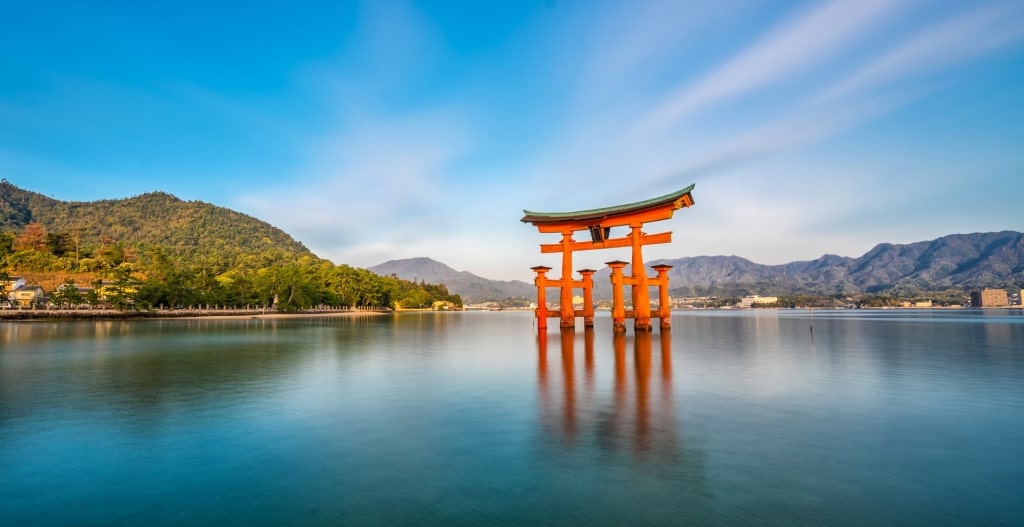
Itsukushima Shrine
Aside from its bounty of statues, another reason the shrine is so popular is because of its proximity to Itsukushima Shrine, one of the most beautiful places in Japan.
It’s an often-photographed site, famous for its bright orange torii gate that stands partially underwater at high tide.
When visiting Daisho-in, consider leaving some extra time to ascend Mount Misen; the temple that sits on a slope near the bottom. While you can hike to the top, most visitors usually opt to take the Misen Tramway, which whisks you to the top of the mountain in about 15 minutes. From there, you’ll have a fantastic view of the entire island, as well as landscapes that stretch back to the mainland.
Kiyomizudera Temple, Kyoto
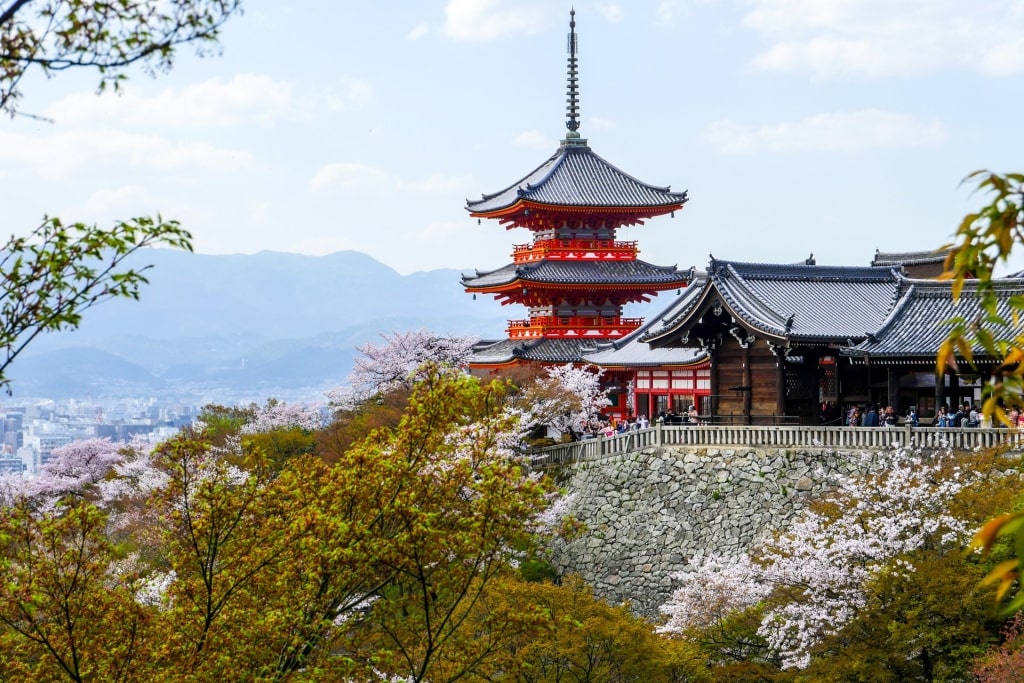
Kiyomizudera Temple, Kyoto
This popular temple in Kyoto sits in one of the city’s most favorable locations: perched near an easy access point to the Otowa Waterfall, which is said to have healing powers. Here, visitors can use wooden cups to drink from the flowing water, which supposedly grants various benefits like good health or wealth. Since the temple is built on a slope, its massive wooden deck looks down on red and pink cherry and maple trees.
Today, the temple is a UNESCO World Heritage Site and has several buildings beyond the main temple hall. Guests can walk through the leafy gardens, visit the Jishu Shrine, which is said to provide luck in love, or visit the Koyasu Pagoda, where worshippers ask for an easy and painless childbirth.
The route to Kiyomizudera is one of the reasons why it’s one of the most famous temples in Japan. While you can certainly take a taxi to the main gate, it takes about a 20-minute walk from the closest subway stop to reach the temple.
Consider walking through the Higashiyama District, strolling down the famous Ninenzaka steps on the way. The district is arguably Kyoto’s most beautiful, with old-fashioned facades, confectionary and craft shops, and cobblestone streets dotted with bonsai and oak trees. It’s a popular spot for photoshoots and coming-of-age geisha ceremonies.
Todai-ji Temple, Nara
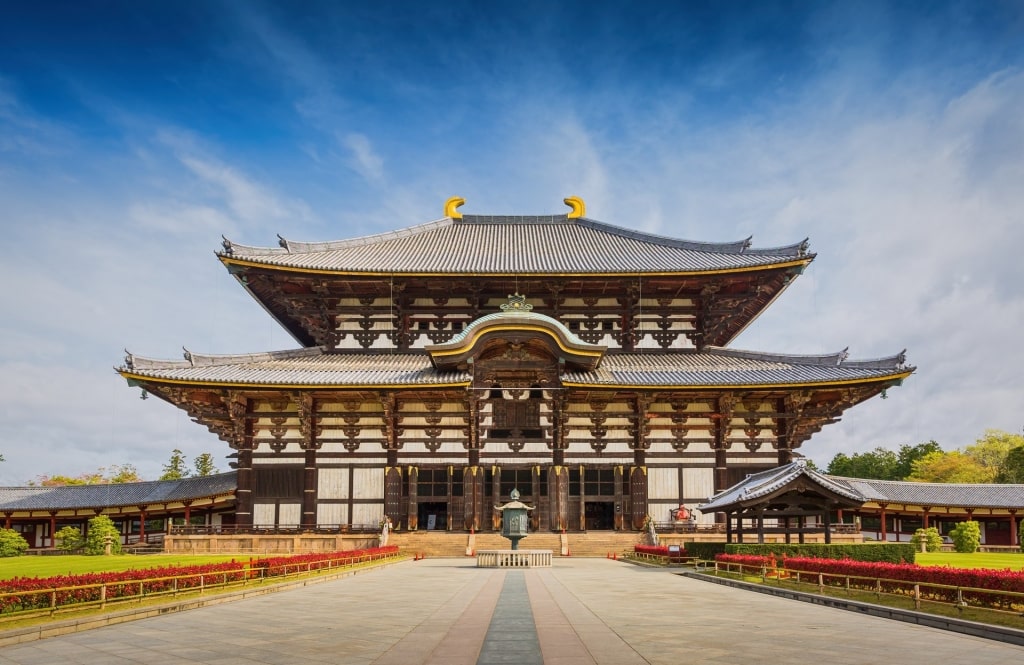
Todai-ji Temple, Nara
No visit to Kyoto is complete without a quick side trip to Nara, the first permanent capital of Japan. This beautiful Japanese city is famous for its sacred deer that wander around and with plenty of museums, gardens, restaurants, shops, shrines, and pagodas, there’s plenty to fill your time. However, you’ll want to be sure not to miss one site in particular: Todai-ji Temple.
This temple is one of the largest in Japan and certainly the most famous in Nara. It was the most important Buddhist temple in the country during Nara’s reign as the capital, from around 750 to 785 C.E.
Inside, you’ll find one of the world’s oldest wooden buildings, as well as a 45-foot-tall Buddha statue and, oddly, a recreation of the Buddha’s nose. It’s a tradition for visitors to attempt to crawl through the nostril for good luck, although most don’t make it through.
Outside of the temple, you can stroll through the large gates that are guarded by wooden deities, walk through the gardens, visit the Todai-ji Museum, and even feed the friendly deer that roam the temple grounds with deer-safe crackers that are available to buy from small vending machines around the property.
Seiryu-ji Temple, Aomori
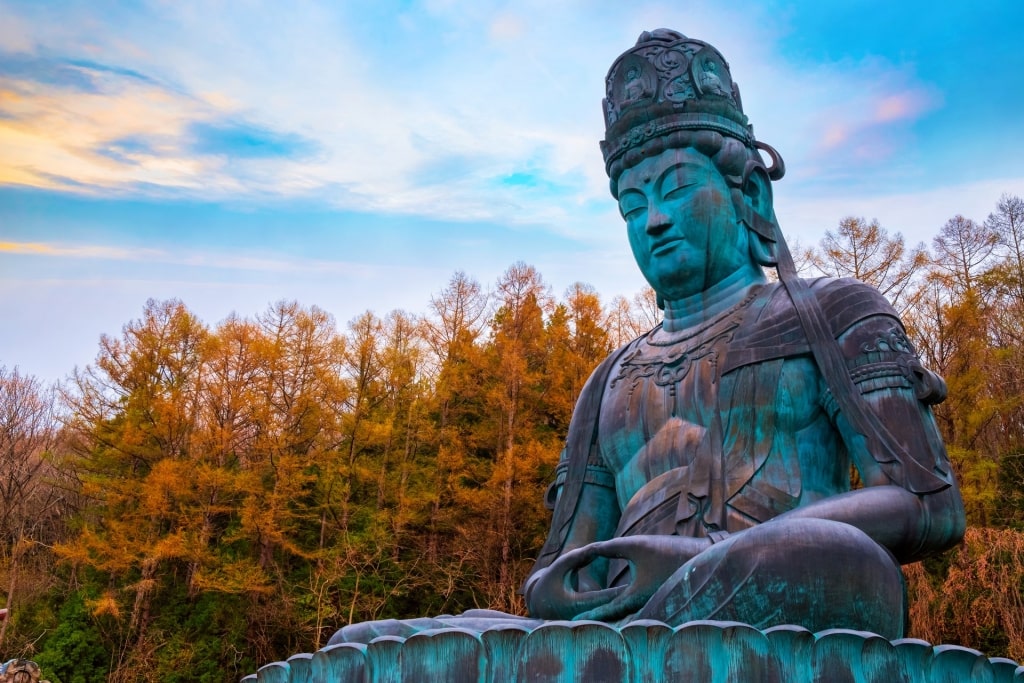
Seiryu-ji Temple, Aomori
Seiryu-ji Temple in Aomori doesn’t get nearly as crowded as the others on this list, which is surprising as it’s undoubtedly one of the best temples in Japan. Seiryu-ji Temple is where you’ll find the largest seated bronze Buddha sculpture in Japan.
Known as Showa Daibutsu, it’s 70 feet tall and far larger than sculptures you’ll find in more popular cities. The Buddha is located outdoors, which allows guests to visit year-round, and sits next to other sites worth seeing, including one of Japan’s tallest pavilions and a Buddha museum.
As far as temples go, Seiyu-Ji is very welcoming. Visitors can wander the property at their leisure, stop in at the simple tea house for a small snack, or even sit outside the Buddha and meditate in the shade. It’s a lovely ride out to the temple and is well worth the short drive.
Chikurin-Ji Temple, Kochi
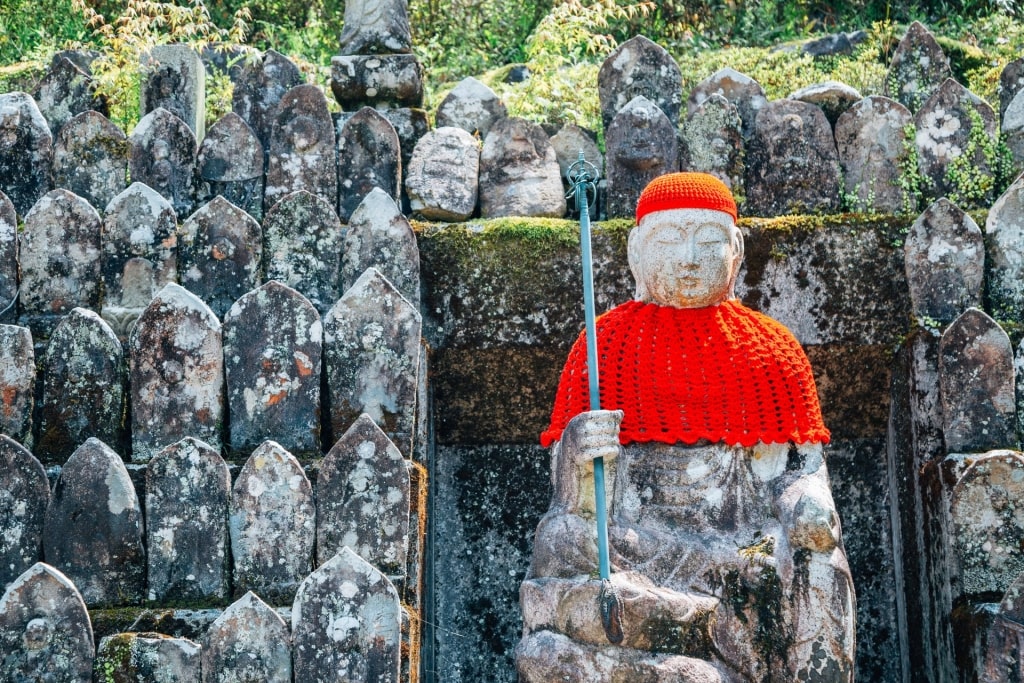
Chikurin-Ji Temple, Kochi
Chikurin-Ji Temple in Kochi is one of the most famous temples in Japan for devotees and travelers that value historical and religious art and artifacts. It’s well-known for housing dozens of statues and items from when Japan’s capital was Edo, which is now called Tokyo.
It’s one of the 88 temples Buddhist monks must visit throughout the country when making the Shikoku Pilgrimage. As one of the largest and most beautiful temples on the route, Chikurin-Ji Temple held special importance to monks who would traditionally visit all 88 temples on foot to prove their devotion.
While the entire complex is beautiful, it’s probably most well-recognized for its five-story red pagoda, which sits above the treeline and is the perfect spot for beautiful photos, especially around dusk.
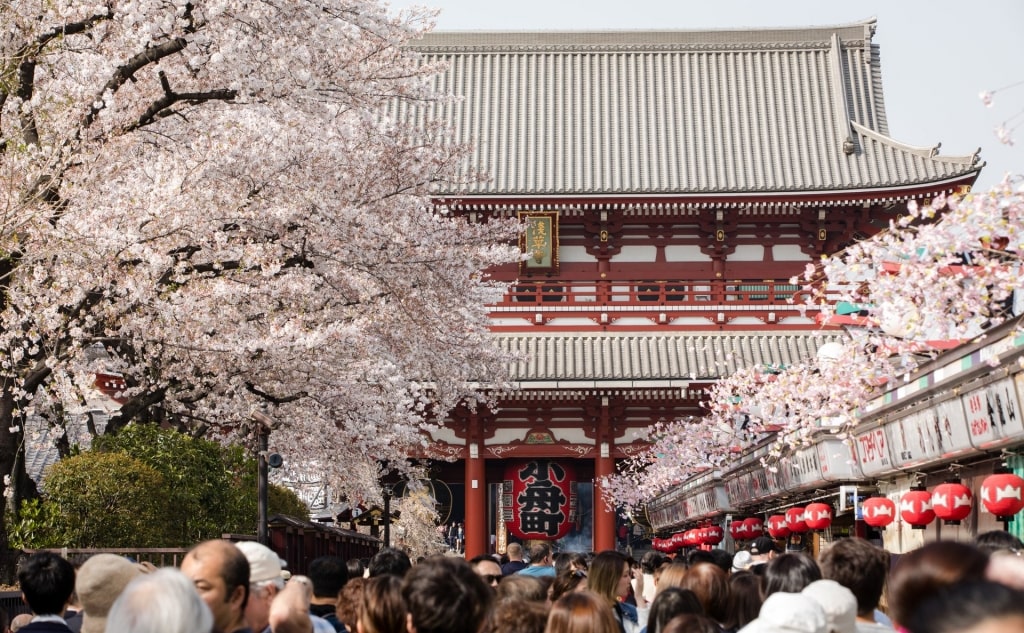
Senso-ji Temple, Tokyo
Discover these temples and more on a cruise to Japan with Celebrity Cruises. Browse cruise itineraries on our website to book your next unforgettable vacation.
